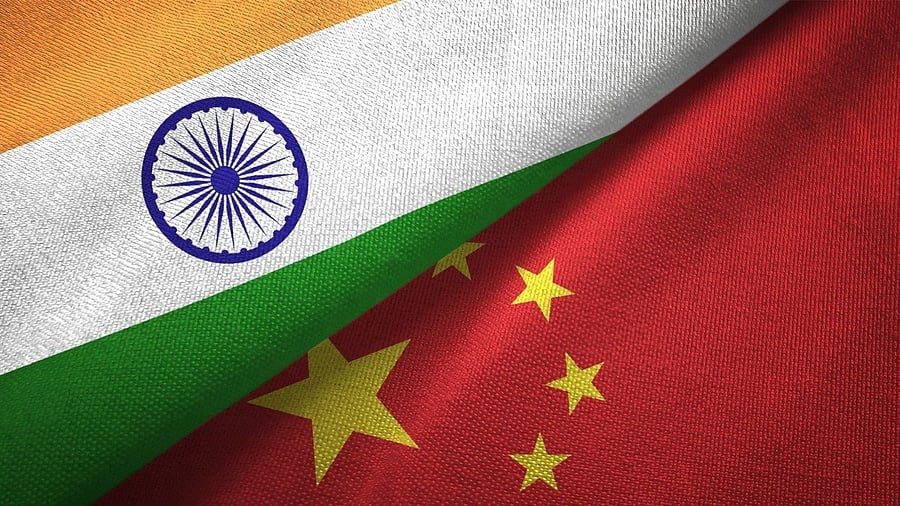
The flags of India and China.
Credit: iStock Photo
The world’s rare earths contest has become a championship boxing match — one in which India, neither mere spectator nor leading pugilist, now finds itself uncomfortably close to the ropes.
The global chip war between the United States of America and China, sparked by semiconductors but spreading to critical minerals, is turning the essential elements of the technological age — neodymium, praseodymium, dysprosium, terbium, and yttrium — into strategic weapons. With each new round, the risk grows that the world’s second-most populous economy will become collateral damage, as much a hostage to supply shocks and fraught geopolitics as to its own strategic choices.
India’s sectoral dependence on rare earths is not a problem that is easily resolved. At the heart of its defence modernisation, automotive electrification, and digital leap lies an omnipresent ingredient: rare earth elements. These 17 metals, cornerstones of permanent magnets, precision optics, energy storage, and guided munitions, make possible everything from fighter jet guidance systems to electric vehicle (EV) motors and computers.
A paltry number
Indeed, India’s ambitions for energy transition and military self-reliance are shackled to components whose origins are concentrated in the hands of a single rival — China. Nearly 60% of India’s imports of rare earths and their derivatives arrive from Chinese companies, which retain not only control of the material supply but also mastery over refining, separation, and magnet fabrication.
Of an estimated 6.9 to 8.5 million tonnes in Indian reserves, actual annual mine output is below 3,000 tonnes — a paltry 0.7% of the global number.
This chasm between domestic potential and industrial performance is no accident: ecosystem bottlenecks, environmental regulation, and the dead hand of a State monopoly have long left India exposed to Beijing’s right hook.
Scratch the surface and you see that India’s rare earths mining story is one of missing a deeper dig. On paper, India boasts vast reserves of these minerals, concentrated mainly in beach sands of the eastern and southern coast — Andhra Pradesh, Odisha, Kerala, and Tamil Nadu.
Yet the reality of State-led mining and processing has quashed innovation and discouraged investment. Monazite, India’s predominant rare earth ore, is radioactively ‘contaminated’ with thorium, requiring arduous clearances and leaving project timelines hobbled by safety bureaucracy.
So, India finds itself not in a prize fight, but on a treadmill.
Flickers of hope
The consequences of India’s rare earth dependence are dangerous. History offers ample warning: when China cut off rare earth exports to Japan in 2010 following a maritime dispute, Tokyo’s electronics and automotive supply chains staggered. With the US now restricting semiconductor technology to China, Beijing has responded with massive controls on rare earth shipments.
India, whose manufacturing and ‘Make in India’ dreams are built atop globalised supply chains, is thus caught between two heavyweights — both eager to test each other’s chin, but neither likely to back down quickly. Indian industry, arrayed for combat but with little cover, risks being the bloodied bystander.
Yet, New Delhi has shown flickers of recognition — if not always of urgency. Recent years have seen an acceleration of policy reforms to pump life into a dormant sector: critical minerals have been identified, private mining participation allowed, and the funding of new processing facilities and public-private partnerships encouraged.
The flagship ‘India Rare Earths Mission’ aims to catalyse domestic capacity, while new bilateral and multilateral agreements seek to bolster alternative sources of supply. There is crucial investment too in academic research and special economic zones — ‘theme parks’ and demonstration plants in Odisha and Bhopal — all designed to move India up the rare earth value chain from ore to magnet to finished product.
Invest in infrastructure and diplomacy
Still, the road is arduous, and recent diplomatic manoeuvres underscore both the strategic opportunity and the risk. With domestic ramp-up slow, India has scouted supplies in Myanmar, whose Kachin region is one of the world’s most important sources of heavy rare earths. This foray, though seemingly logical, is a high-stakes gambit. The supply lines from Kachin are long and tortuous, frequently controlled by local guerrilla factions whose own alliances are as volatile as the region’s politics.
China watches these moves warily. To source meaningful quantities, India will have to invest in infrastructure and diplomacy, as well as in technical capacity at home, or risk swapping one form of dependence for another. The lesson of the boxing ring returns: footwork and neck strength count as much as the right hook.
As for the industrial future, the stakes are unusually high. Telecom infrastructure, renewable power, and defence electronics — all sit uncomfortably close to a bottleneck controlled by a Chinese adversary already emboldened by recent demonstrations of economic coercion. Put differently, if the global chip and rare earths war continues to develop, it could well hobble India’s growth.
Plan B needed
What then is to be done? A comprehensive ‘Plan B’ is no longer optional, but existential. India must redouble its push for domestic exploration and extraction, modernise its refining technology, and rapidly develop a skilled workforce capable of closing the technological gap with its Asian competitors.
At the same time, partnerships must extend beyond Myanmar, drawing in Australia and other like-minded states willing to pool their strengths. Environmental regulation — critical for public acceptance — should be modernised, not in the service of delay, but of sustainable and efficient production. Strategic reserves, seen as old-fashioned in an era of global just-in-time manufacturing, may soon become essential buffers.
This contest of critical resources is one of endurance, demanding not just tactical jabs but deep reserves of resilience, agility, and strategic vision.
In the new great game of minerals, the final bell has not yet rung — but India needs to move, fast, invest upfront and secure foreign supplies. Otherwise, it risks an industrial standstill from which extraction will be very complicated.
Ninad D Sheth is a senior journalist. X: @ninadsheth.